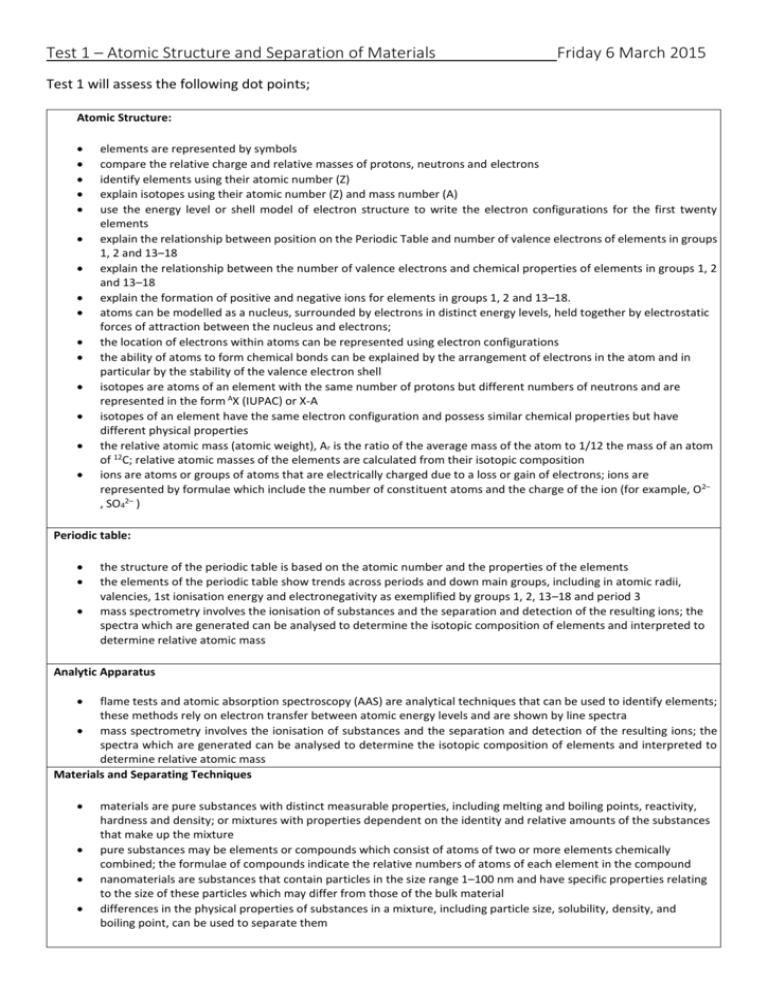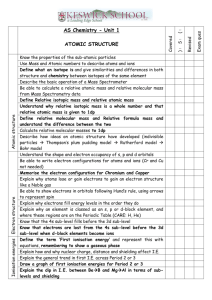File
advertisement

Test 1 – Atomic Structure and Separation of Materials Friday 6 March 2015 Test 1 will assess the following dot points; Atomic Structure: elements are represented by symbols compare the relative charge and relative masses of protons, neutrons and electrons identify elements using their atomic number (Z) explain isotopes using their atomic number (Z) and mass number (A) use the energy level or shell model of electron structure to write the electron configurations for the first twenty elements explain the relationship between position on the Periodic Table and number of valence electrons of elements in groups 1, 2 and 13–18 explain the relationship between the number of valence electrons and chemical properties of elements in groups 1, 2 and 13–18 explain the formation of positive and negative ions for elements in groups 1, 2 and 13–18. atoms can be modelled as a nucleus, surrounded by electrons in distinct energy levels, held together by electrostatic forces of attraction between the nucleus and electrons; the location of electrons within atoms can be represented using electron configurations the ability of atoms to form chemical bonds can be explained by the arrangement of electrons in the atom and in particular by the stability of the valence electron shell isotopes are atoms of an element with the same number of protons but different numbers of neutrons and are represented in the form AX (IUPAC) or X-A isotopes of an element have the same electron configuration and possess similar chemical properties but have different physical properties the relative atomic mass (atomic weight), Ar is the ratio of the average mass of the atom to 1/12 the mass of an atom of 12C; relative atomic masses of the elements are calculated from their isotopic composition ions are atoms or groups of atoms that are electrically charged due to a loss or gain of electrons; ions are represented by formulae which include the number of constituent atoms and the charge of the ion (for example, O2– , SO42– ) Periodic table: the structure of the periodic table is based on the atomic number and the properties of the elements the elements of the periodic table show trends across periods and down main groups, including in atomic radii, valencies, 1st ionisation energy and electronegativity as exemplified by groups 1, 2, 13–18 and period 3 mass spectrometry involves the ionisation of substances and the separation and detection of the resulting ions; the spectra which are generated can be analysed to determine the isotopic composition of elements and interpreted to determine relative atomic mass Analytic Apparatus flame tests and atomic absorption spectroscopy (AAS) are analytical techniques that can be used to identify elements; these methods rely on electron transfer between atomic energy levels and are shown by line spectra mass spectrometry involves the ionisation of substances and the separation and detection of the resulting ions; the spectra which are generated can be analysed to determine the isotopic composition of elements and interpreted to determine relative atomic mass Materials and Separating Techniques materials are pure substances with distinct measurable properties, including melting and boiling points, reactivity, hardness and density; or mixtures with properties dependent on the identity and relative amounts of the substances that make up the mixture pure substances may be elements or compounds which consist of atoms of two or more elements chemically combined; the formulae of compounds indicate the relative numbers of atoms of each element in the compound nanomaterials are substances that contain particles in the size range 1–100 nm and have specific properties relating to the size of these particles which may differ from those of the bulk material differences in the physical properties of substances in a mixture, including particle size, solubility, density, and boiling point, can be used to separate them You should have completed the following; □ Set 2: Composition of Matter □ Set 9: Electronic Structure and the Periodic Table □ Set 15: Periodic Trends □ Chapter 1 Review Questions (Nelson) □ Set 4: Mixtures, Pure substances and Separation Techniques □ Chapter 2 Review Questions (Nelson) Your textbook (Nelson) and the Exploring Chemistry Yr 11 (STAWA) is another source of revision questions. Chapters 1 to 2 are the sections we have covered.









